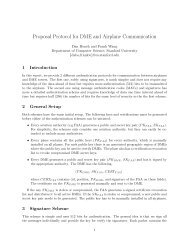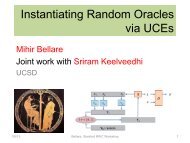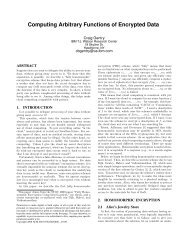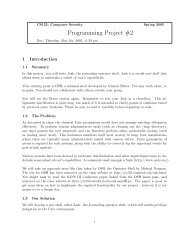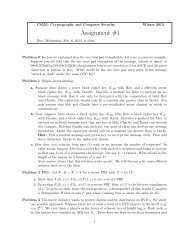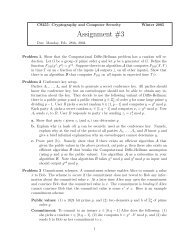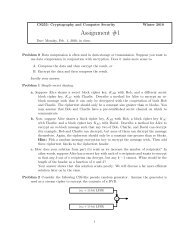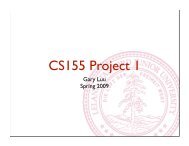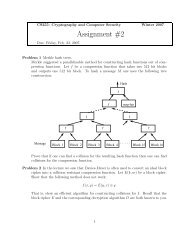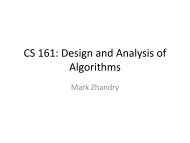Auditing SQL Queries - Stanford Crypto Group - Stanford University
Auditing SQL Queries - Stanford Crypto Group - Stanford University
Auditing SQL Queries - Stanford Crypto Group - Stanford University
Create successful ePaper yourself
Turn your PDF publications into a flip-book with our unique Google optimized e-Paper software.
We will now introduce our new notions of suspiciousness,<br />
design auditors for them, and discuss their disclosure detection<br />
guarantees. Please see a technical report at [10] for discussions<br />
and proofs of some of the results that have been omitted here<br />
for lack of space.<br />
III. SEMANTIC AUDITING<br />
The work that we first chose to build on was that of [2]<br />
since the notion of suspiciousness here is more relaxed than<br />
prefect privacy suspiciousness and allows for simpler auditors.<br />
The authors however, only considered detecting queries that<br />
on their own accessed all the forbidden columns of one or<br />
more of the tuples of a forbidden view. In general, no one<br />
query in isolation may have accessed all the audit list<br />
columns of a forbidden tuple, though a few queries together<br />
could have For example, the audit expression might be<br />
AUDIT p.name, p.disease FROM Patients p<br />
WHERE p.zipcode = 94305<br />
Here the data that needs to be kept secret is the association<br />
between names and diseases of patients living in the zipcode<br />
94305. Now consider the <strong>SQL</strong> queries:<br />
SELECT p.zipcode FROM Patients p<br />
WHERE p.disease = ‘diabetes’<br />
SELECT p.name FROM Patients p<br />
WHERE p.zipcode = 94305<br />
Neither query on its own could have revealed the name-disease<br />
association of anyone living in 94305 to an attacker with no<br />
background knowledge of people living in 94305. However<br />
the combination of the queries could have. For instance, if<br />
there was only one patient in 94305 and he had diabetes, then<br />
these queries revealed his name-disease association. There are<br />
subtle ways in which the results of queries could be combined<br />
to reveal information and in the notion of suspiciousness we<br />
introduce here, informally, we seek to capture disclosures of<br />
the audit list columns that could be caused by an attacker<br />
“joining” query results that contain tuples corresponding to<br />
forbidden tuples.<br />
We assume that attackers are powerful and know exactly<br />
which tuples in the results of different queries come from the<br />
same individual and can be “joined”. The resulting suspiciousness<br />
definition is conservative: it may label query batches as<br />
suspicious when a user could not have easily mapped result<br />
tuples to a particular individual in reality.<br />
Since this form of suspiciousness derives meaning from<br />
a particular world view, i.e., the current database state, we<br />
call it semantic suspiciousness. This is in contrast to syntactic<br />
suspiciousness defined later, where suspiciousness of a batch<br />
depends entirely on the structure of the queries in the batch,<br />
not on the actual database state.<br />
Definition 6: (Semantically Suspicious Query Batch) A<br />
query batch Q is semantically suspicious with respect to an<br />
audit expression A if there is some subset of queries Q ′ ⊆Q<br />
and some tuple t ∈T (the cross-product of tables common to<br />
A and every query Q ∈Q ′ ) such that (1) t is indispensable to<br />
both A and every Q ∈Q ′ and (2) the queries in Q ′ together<br />
access all the audit list columns of A.<br />
Semantic suspiciousness is a natural extension of the definition<br />
in [2] and we construct an auditor for it.<br />
Theorem 1: Auditor 1 determines exactly if an SPJ query<br />
batch Q is semantically suspicious with respect to audit<br />
expression A.<br />
Algorithm 1 Semantic Auditor<br />
1: // D=cross-product of tables occurring in A or some Q ∈Q<br />
2: compute V = π∗(σP A (D)) on the given database instance<br />
3: for every query Q ∈Q<br />
4: for every tuple t ∈ V<br />
5: if t satisfies the WHERE clause predicates of Q<br />
6: mark all columns of t accessed by Q<br />
7: if all audit list columns of some t ∈ V are marked<br />
8: return suspicious.<br />
9: else return unsuspicious.<br />
To determine exactly the subset of queries involved in the<br />
disclosure, the auditor can maintain with each marked cell,<br />
the set of queries that accessed it. The cross-product of all the<br />
query sets for each cell of each disclosed tuple gives all the<br />
query subsets Q ′ that could have caused the disclosure.<br />
We omit a proof due to space constraints. The idea is that<br />
if a tuple t ∈ V satisfies the predicates of a set of queries Q ′ ,<br />
then the part of t, t ′ , that comes from the cross-product of<br />
tables common to all queries in Q ′ and A is indispensable<br />
to every query in Q ′ and A. This is because the queries<br />
are duplicate-preserving: every input tuple that satisfies their<br />
predicates results in a corresponding output tuple. So removing<br />
t ′ causes a difference to all the query results.<br />
Note that as in [2], we require the query batch to access all<br />
the audit list columns in order to be even considered for<br />
suspiciousness testing. This is because informally, we would<br />
ideally like to determine “full disclosure” of a forbidden tuple,<br />
i.e., could any combination of queries in the query batch have<br />
revealed all the audit list columns of a forbidden tuple<br />
to an adversary. This is motivated by findings such as in<br />
[16] where attributes such as date-of-birth, gender or zipcode<br />
on their own are not selective, however in conjunction can<br />
uniquely identify individuals. In such a case, revealing the<br />
diseases of all females in a zipcode is likely to be harmless,<br />
however revealing this in conjunction with dates-of-birth could<br />
cause significant privacy breaches.<br />
We discuss the disclosure detection abilities of a semantic<br />
auditor in more detail in Section V. Briefly, just like the auditor<br />
of [2], it does not catch query batches that could have caused<br />
disclosure of the audit list columns due to the absence<br />
of forbidden tuples in query results. In fact the problem of<br />
negative disclosures becomes even more amplified for multiple<br />
queries since many negative disclosures together could add up<br />
to a lot of positive disclosure. It is partly due to this that we<br />
study other definitions of suspiciousness. Another reason is<br />
that executing every single query in Q against the forbidden<br />
view could be an expensive operation if the query log and the<br />
forbidden view are large. In the following section we consider



